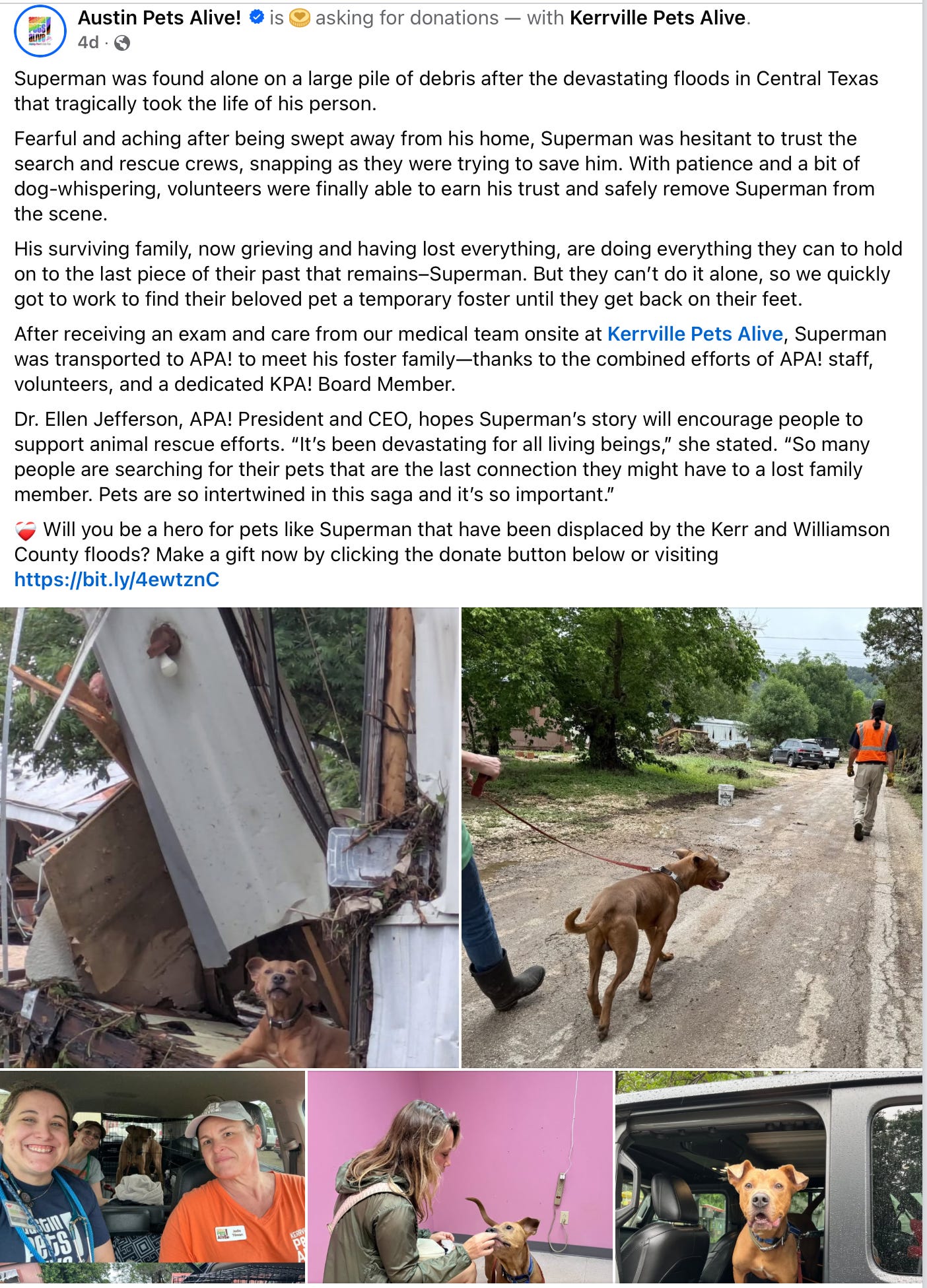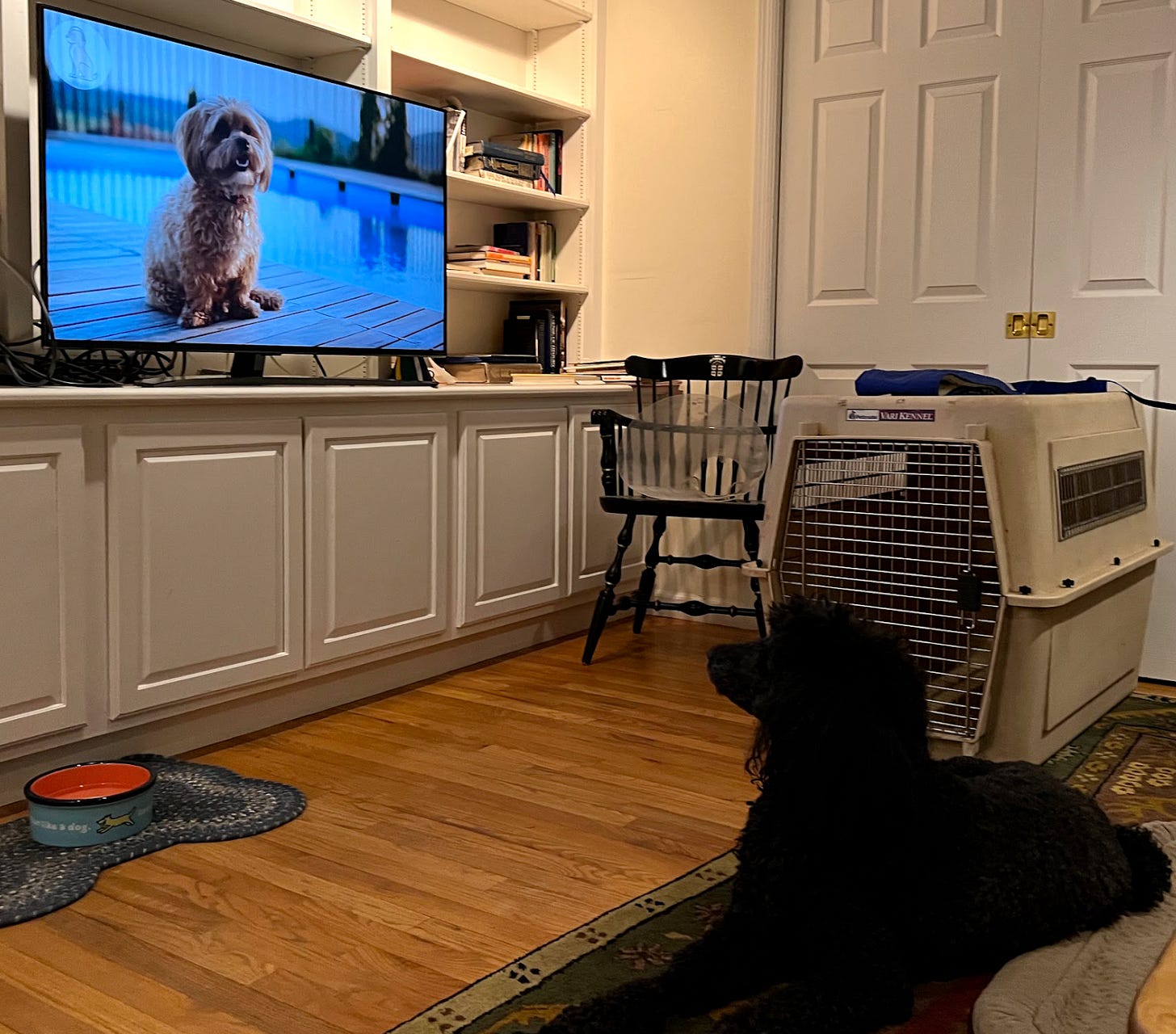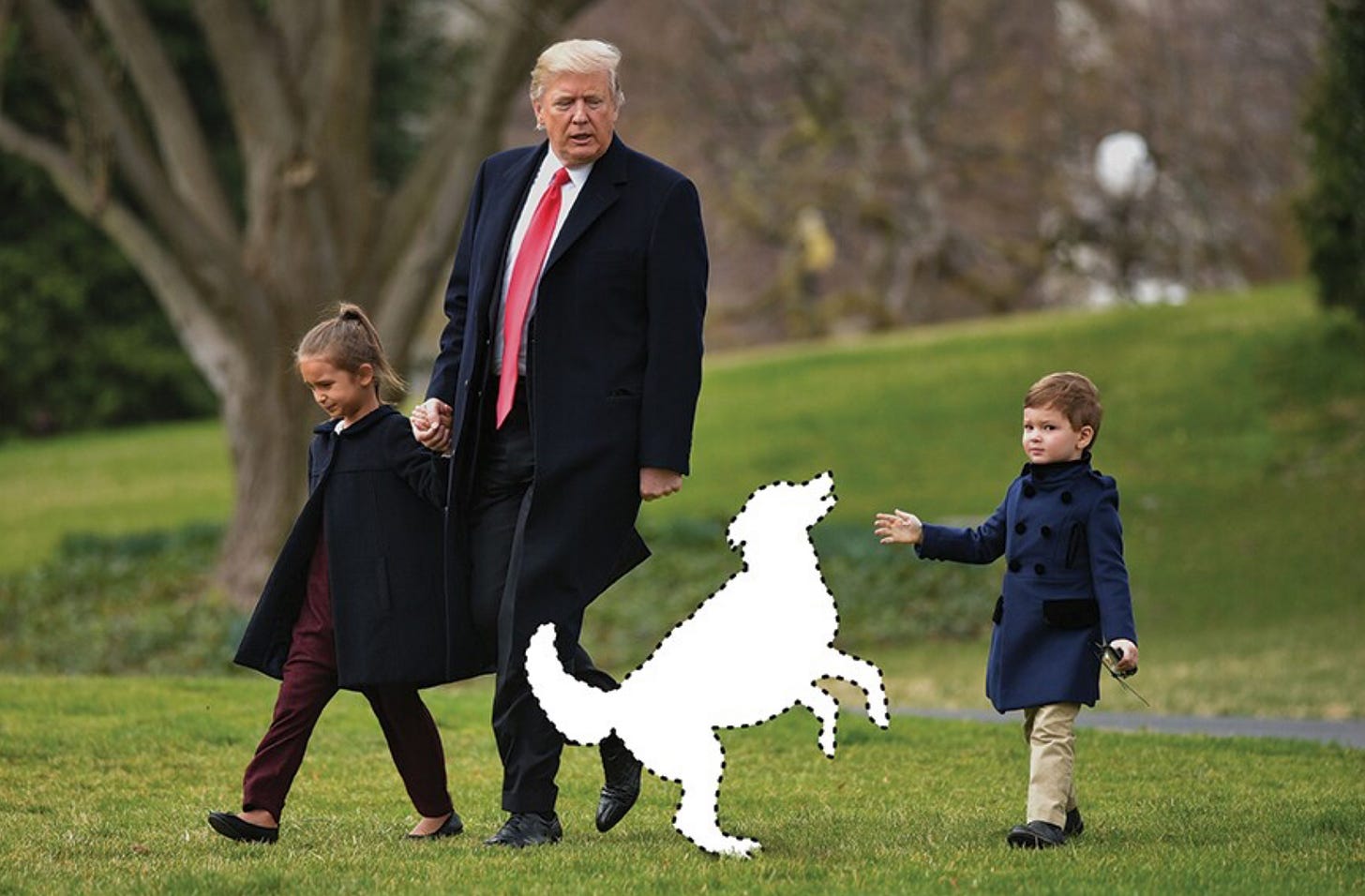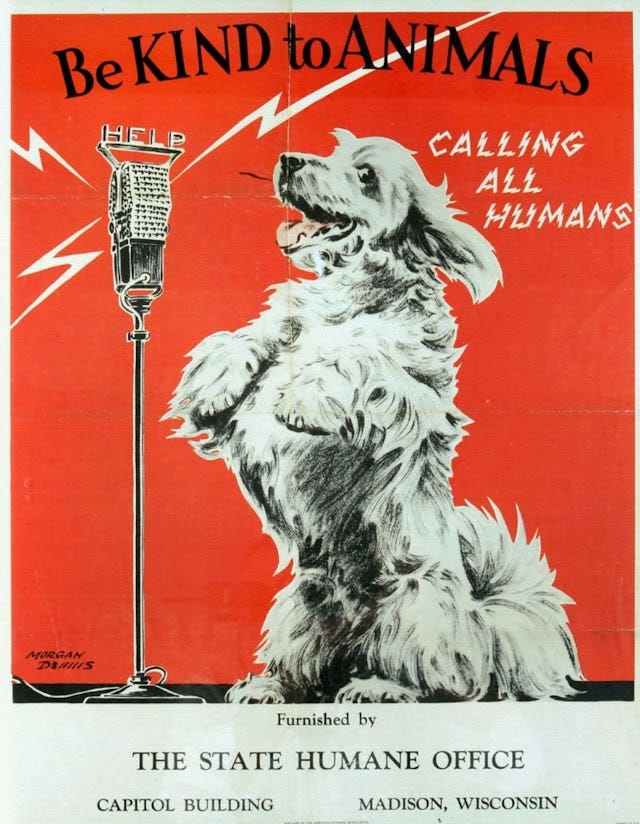A Message from Casey, the Miracle Poodle, to Superman, the Miracle Texas Flood Dog - and all other living creatures in distress
Don’t give up hope! Miracles happen! I know! What we dogs are here to teach you is that if a fellow creature is suffering, you’ve got to hear their cry.
Hi everybody. I’m Casey and I turn seven on Aug. 1. That’s 49 in dog years, but they still treat me like a kid! No one thought I’d make it to this birthday. My dad, Rabbi Joshua Hammerman (I just call him “Dad,”) asked me to write today’s column and offered me two extra treats if I did it. He feels you need a break from the craziness all around us - I mean, can you believe all this thunder we’ve been having? And my walks have been shortened because of the heat. But I still like walking over to the beach and meeting lots of other people and dogs along the way! My two siblings, Cassidy and Cobie would much rather stick closer to home!
You may have heard about me because of my recent battle with cancer. They called it incurable, and it still probably is, but I completed the treatments back in January and so far, it hasn’t come back. This week, after another clean check-up, the vet called me a rock star, “the perfect poodle,” and said she thought I would have crossed that Rainbow Bridge months ago. She can’t explain why I’ve lived this long. “It’s not in the literature,” she said. Meanwhile, my family and me - we’re just enjoying the ride.
I looked pretty skinny on my last day of chemo. But this week the doctor said, “He looks like a different dog!”
Now, when people come over to visit, they are suddenly treating me like a new Lamb Chop toy. They want to lay their hands on my head and pet me and have me chew on their dogs’ shmattes. I swear they would drink from my bowl if Dad let them! Everyone thinks I’m special.
I get it. Even dogs who haven’t survived a deadly disease are very special to people. I’ve heard my dad quote Mary Oliver, who wrote, “Because of the dog's joyfulness, our own is increased. It is no small gift.”
And Roger Caras, the guy who is always introducing the dogs at the Westminster Dog Show that my mom makes me watch on TV, said, “Dogs are not our whole life, but they make our lives whole.”
Right now, there are human tragedies, due to floods, and downright cruelty to immigrants, and in each of these cases hundreds of animals are also suffering. I was especially sad to read about this dog, a survivor like me, who somehow made it through last week’s flood in Texas:
See also: Saving Superman: Shelter hopes story of dog rescued from Texas flood debris will help save others
By the way, right before I got cancer, I was laid up for 6 months with two ACL surgeries. The surgeries were expensive, and not everyone is as lucky as I am (my parents are NOT asking for donations!), but there are lots of animals out there who need help! It was hard for me, but I got used to watching lots of Dog TV!
It’s not just storms that are tearing dogs from their owners these days. Can you believe a Colorado grandfather was nabbed by the human-catcher (I think they call it ICE, but I call ‘em Cruella) - while walking his dog? Talk about the lowest of the low! I hope the dog peed on him!
Speaking of which, dogs have a foolproof way of marking their territory and identifying themselves. Maybe humans should follow our lead, and if anyone questions their identity at a voting booth, just pee on ‘em. And if they ask for two kinds of identification, a simple butt sniff should do the trick.
Unfortunately, many pets are being left behind when their owners are captured by these creepy ICE people.
I think dogs have never been as important as they are now. It’s not like we ignore danger, but we don’t let our troubles weigh us down.
Jennifer Skiff, author of “The Divinity of Dogs,” wrote, “Dogs, for a reason that can only be described as divine, have the ability to let go of the past and live each day joyously. It is something the rest of us strive for.”
We just want to make people smile. So we can help people get through this and, para-dog-sically, we non-humans can be a key for people maintaining their humanity under an inhumane regime.
According to my dad, the way humans and their pets interact can help remind humans how to treat other people. We dogs are here to teach you is that if a fellow creature is suffering, you’ve got to hear their cry (or whimper). While you are trying to train us to make on the newspaper, we are trying to train you to read the newspaper, and to be kind.
Did you know that only three US presidents have not had a pet? James K Polk, Andrew Johnson, and the current guy. A slave owner, a white supremacist…and this guy. “Donald was not a dog fan,” his ex-wife Ivana confirmed in her memoir Raising Trump, recalling his hostility to her poodle, Chappy, who would “bark at him territorially”.
Trump would hate my poodle brother Cobie. He’s a barker. On the other hand, he’s white.
To be honest, Jews have had their ups and downs with dogs over the centuries. But despite that, Judaism (my parents’ religion) talks a lot about how wrong it is to abuse animals.
To explain that better, here’s something my dad wrote for you - I get an extra cookie for sharing it! Meet you on the other side. You know, I kind of like this Substack thing. After all blog rhymes with dog!
ANIMAL RIGHTS (AND WRONGS): WHY PET LIVES MATTER:
By Casey Hammerman’s Dad
Caring for animals is a prime Jewish value, most notably (and somewhat ironically) expressed in the laws of kashrut, which require that animals be slaughtered in the most painless manner possible. The Torah could not be clearer when it instructs us (Exodus 23:5) to assist the animal of your enemy. In that verse, the animal is a donkey that has been mistreated, presumably by its owner. Based on this law, the rabbis established the concept of “tza’ar ba’ale hayyim,” calling on us to minimize the suffering of all living creatures, literally to “feel their pain” in a Bill Clinton sort of way.
(This is Casey again. Who the ruff is Bill Clinton? And didn’t he have a cat?)
Cruelty to animals is strictly forbidden, in part because feeling animals’ pain trains us to treat people with similar reverence. After all, Moses, David and other great leaders gained their leadership chops as caring shepherds.
In Numbers 22:28, when the Midianite prophet Balaam’s donkey is given the ability to speak, she confronts him, asking, "What have I done to you that deserves your beating me three times?" That single comment speaks volumes about the Jewish attitude toward other sentient beings.
That’s important, because there seems to be a deep-seated human urge to see animals suffer, which we’ve learned to partially suppress. When Ringling Bros. & Barnum and Bailey Circus shut down several years back, spokespeople stated that the elimination of elephants, which had been announced a year before in response to growing animal rights protests, led directly to the demise. But Ringling Bros.’ fate was sealed not so much by the removal of their pachyderms then by their horrific mistreatment for decades.
Similarly, Sea World saw its attendance decline following protests from animal rights groups. The theme park underwent a massive rebranding as “Shamu’s Happy Harbor” in an attempt to convince the world that orcas are lining up to exchange their precious freedom for a chance to eat unlimited amounts of herring. People weren’t buying it. Happy Harbor shut down in 2022 and was replaced by Sesame Street.
American Jews had an animal rights scandal all our own, the inhumane conditions discovered at the now bankrupt Agriprocessors meat processing plant. Coincidentally, Donald Trump commuted the sentence of the perpetrator.
Western society has come a long way in its sensitivity toward animals - in Elizabethan England, for instance, bloody dog fights were ubiquitous - but we’ve a long way to go. For example, some consider the sport of horse racing to pose unnecessary risks for the animals.
Jews have a long history of opposing activities like hunting for sport and cockfighting. The case of Michael Vick, the football star who ran a dog fighting ring and later spoke out against animal cruelty, sensitized many to the need for vigilance against animal abuse, and the first line of defense is the neighbors, which in the case of your neighbor’s beagle, is you. We are all responsible.
The Jerusalem Talmud (Avoda Zara 1:7) goes as far as to state that even the person who sits in a stadium simply to watch gladiatorial combat (which often involved animals) “spills blood,” and Jews were prohibited from selling bears and lions for use in those stadiums.
Interestingly, there is some evidence of Jews being involved in bullfighting. The Talmud relates that “a bull of the arena [that killed a person] is not liable to the death penalty (Bava Kamma 39a.)” The commentary of Tosafot a few pages earlier (24b) contends that these bulls were trained to fight people – not other bulls. These animals could not be held responsible simply for doing what they were trained to do. It’s amazing to think of the degree of compassion the sages had even for animals turned lethal.
As far as our own pets are concerned, we should refrain from eating our own meals until we’ve fed them and Jews are not permitted to buy cattle, beasts or birds unless we can adequately care for them. Our animals even get to observe Shabbat, during which we are prohibited from placing any burden at all on them.
Casey here again:
My dad believes that animals have the capacity to empathize. And when he says that, I can feel his pain! I’m the first one to comfort him when he’s down (Cassidy and Cobie, not so much). He says that recent studies have shown that dogs respond quickly to humans crying, rats empathize with their friends (they even bring home pizza) and elephants grieve the passing of herd members.
Unfortunately, there are people around who hate animals, who call all their enemies “dogs” and claim immigrants in Ohio are eating us. They hate dogs but love dog whistles. If someone is so unfeeling toward animals, I wouldn’t trust them around people! Their finger should never be close to the pooper scooper button.
See Noem’s dog killing was bad, but to really understand her, consider the goat (North Dakota Monitor)1
So here’s my point, which my dad wanted me to share:
If a fellow creature is suffering, you’ve got to do something.
Article from North Dakota Daily Monitor:
Since Gov. Kristi Noem’s disclosure of her farmyard killing spree, everybody’s been focused on Cricket.
That’s understandable. Cricket was a 14-month-old dog. It’s easy to imagine her head jutting out of a pickup window, hair and tongue blowing in the wind. Like many dogs, Cricket probably had a personality and other human-like qualities that we so often attribute to canine companions.
Noem shot and killed Cricket on some undisclosed date years ago for being bad at pheasant hunting and good at chicken hunting. The moral, Noem wrote, is that leaders deal with problems immediately. That makes her a “doer,” she claimed, not an “avoider.”
That’s pure bunk, as millions of people have pointed out in an avalanche of criticism since The Guardian obtained an early copy and revealed some of the contents of Noem’s ironically named memoir, “No Going Back.” The relevant pages have since been shared with South Dakota Searchlight, which requested an advance copy but was ignored; the book’s official publication date is next Tuesday.
Again, the focus on Cricket makes sense, because we can all see that Noem could’ve taken the dog to a shelter and given it another chance at life.
But if you’ll hear me out, I want to tell you why Cricket’s fate is the wrong place to focus your attention.
If you really want to understand Kristi Noem, you need to consider the goat.
‘I spotted our billy goat’
After Noem made the death march to her farm’s gravel pit, where she shot Cricket, she was apparently still in an uncontrollable rage.
“Walking back up to the yard, I spotted our billy goat,” Noem wrote.
The nameless goat’s only sin in that moment was being in Noem’s field of view.
In the book, Noem tried to justify her snap decision to kill the goat by writing that it “loved to chase” her children and would “knock them down and butt them,” leaving them “terrified.” The animal also had a “wretched smell.”
But apparently none of that had been a big enough problem to do anything about it. Not until Noem got angry enough to kill a dog and decided she needed to kill again.
Noem says she “dragged” the goat to the gravel pit, “tied him to a post,” and shot at him. But the goat jumped when she shot.
“My shot was off and I needed one more shell to finish the job,” she wrote.
She studiously avoided saying she wounded the goat with the first shot, but that’s the implication.
“Not wanting him to suffer,” she added — apparently experiencing her first twinge of feeling, after saying that killing the dog was not “pleasant” — “I hustled back across the pasture to the pickup, grabbed another shell, hurried back to the gravel pit, and put him down.”
The goat story not only reflects a disturbing lack of self-control, but also raises a question of law.
The crime of animal cruelty
Noem has defended her shooting of the dog, citing legal justification for her actions. She’s likely referencing a state law that exempts from the definition of animal cruelty “any reasonable action taken by a person for the destruction or control of an animal known to be dangerous, a threat, or injurious to life, limb, or property.”
Cricket killed a neighbor’s chickens and “whipped around to bite” Noem when she intervened; therefore, by Noem’s logic, her killing of Cricket was legally defensible. She’s probably right, legally speaking.
But what about the goat?
Sure, it chased children, butted them, and smelled bad. “So, a goat,” Stephen Colbert deadpanned during his Monday monologue on “The Late Show,” speaking for everybody who’s ever been around goats. If those traits meet the legal definition of “dangerous, a threat, or injurious to life, limb, or property,” killing any goat would always be legally justified.
In reality, what Noem did to the goat — dragging it to a gravel pit, tying it to a post, shooting at it once, leaving to get another shell, and shooting it again — sounds an awful lot like the legal definition of animal cruelty. That definition in South Dakota law is “to intentionally, willfully, and maliciously inflict gross physical abuse on an animal that causes prolonged pain, that causes serious physical injury, or that results in the death of the animal.”
Alas, cruelty to animals is a Class 6 felony, and lower-class felonies like that carry a seven-year statute of limitations in South Dakota. We don’t know exactly what year it was when Noem shot her dog and goat. She gave a clue in the book when she wrote that her children came home on the school bus the day of the killings and one of them asked, “Where’s Cricket?” Noem didn’t say how she responded, and all of her children are now grown.
If that was more than seven years ago, the goat killing is probably not prosecutable. But no prosecution could do more damage to Noem’s reputation and career than she’s already done to herself by writing about her animal bloodthirst.
As Noem wrapped up her bloody tale in the book, she wrote that being a leader is often “messy” and “ugly.”
In her case, it certainly is.











Dear Casey,
Mommy and Daddy said you wrote an article, so we read it! Wow, Casey, you're a top-notch writer. We think newspapers might be hiring canine journalists, and since you're feeling so Amazing these days, maybe you should apply to the New York Times...or write a memoir?
We wish you, your mom and dad a Shabbat Shalom! Hope you get lots of good challah,
Delilah and Thunder (and their mommy and daddy)
Casey is the miracle poodle. I love this post! ❤️